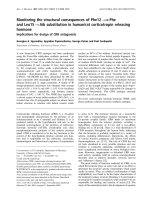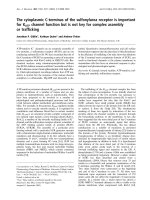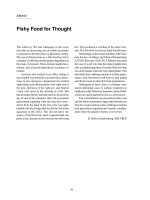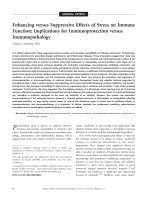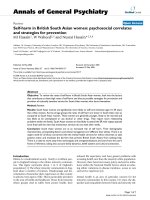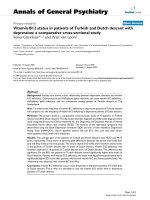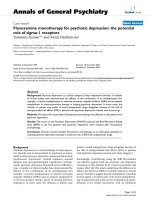Báo cáo y học: "Vitamin supplementation for prevention of mother-to-child transmission of HIV and pre-term delivery: a systematic review of randomized trial including more than 2800 women" potx
Bạn đang xem bản rút gọn của tài liệu. Xem và tải ngay bản đầy đủ của tài liệu tại đây (285.22 KB, 7 trang )
BioMed Central
Page 1 of 7
(page number not for citation purposes)
AIDS Research and Therapy
Open Access
Research
Vitamin supplementation for prevention of mother-to-child
transmission of HIV and pre-term delivery: a systematic review of
randomized trial including more than 2800 women
Edward J Mills*
1
, Ping Wu
2,3
, Dugald Seely
3,4
and Gordon H Guyatt
1
Address:
1
Department of Clinical Epidemiology & Biostatistics, McMaster University, Hamilton, Canada,
2
London School of Hygiene & Tropical
Medicine, London, UK,
3
Division of Clinical Epidemiology, Canadian College Of Naturopathic Medicine, Toronto, Canada and
4
Hospital for Sick
Children, University of Toronto, Toronto, Canada
Email: Edward J Mills* - ; Ping Wu - ; Dugald Seely - ;
Gordon H Guyatt -
* Corresponding author
HIVVitaminsVitamin AMother-to-child transmissionPreterm delivery
Abstract
Background: Observational studies have suggested that low serum vitamin levels are associated
with increased mother-to-child transmission (MTCT) of HIV and increased preterm delivery. We
aimed to determine the efficacy of vitamins on the prevention of MTCT and preterm delivery by
systematically reviewing the available randomized controlled trials [RCTs]. We conducted
systematic searches of 7 electronic databases. We extracted data from the RCTs independently, in
duplicate.
Results: We included 4 trials in our review. Of the three trials on Vitamin A, two suggested no
difference in MTCT, while the third and largest trial (n = 1078) suggested an increased risk of
MTCT (Relative Risk 1.35, 95% Confidence Interval [CI], 1.11–1.66, P = 0.009). Two of the vitamin
A trials addressed the impact of supplementation on pre-term delivery; one suggested a benefit (RR
0.65, 95% CI, 0.44–0.94) and the other no difference. All three vitamin A trials found no significant
effect on infant mortality at 1 year. Of the two trials that looked at multivitamin use, only one
addressed the prevention of MTCT, and found a non-significant RR of 1.04 (95% CI, 0.82–1.32).
Two of the multivitamin trials found no significant effects on pre-term delivery. The single
multivitamin trial examining children's mortality at 1 year yielded a non-significant RR of 0.91 (95%
CI, 0.17–1.17).
Conclusion: Randomized trials of vitamins to prevent MTCT have yielded conflicting results
without strong evidence of benefit and have failed to exclude the possibility of harm.
Introduction
In Africa, 55% of HIV-1-positive adults are women, most
of childbearing age [1]. Data from antenatal clinics show
that in several parts of southern Africa, more than 30% of
pregnant women are infected with HIV-1. The fastest
growth has been in South Africa, where the prevalence of
Published: 06 May 2005
AIDS Research and Therapy 2005, 2:4 doi:10.1186/1742-6405-2-4
Received: 20 January 2005
Accepted: 06 May 2005
This article is available from: />© 2005 Mills et al; licensee BioMed Central Ltd.
This is an Open Access article distributed under the terms of the Creative Commons Attribution License ( />),
which permits unrestricted use, distribution, and reproduction in any medium, provided the original work is properly cited.
AIDS Research and Therapy 2005, 2:4 />Page 2 of 7
(page number not for citation purposes)
infection in adults increased from 5% in 1990, to over
25% in 2002 [1]. Mother-to-child transmission (MTCT)
of HIV-1 can occur during pregnancy, delivery, and post-
partum through breastfeeding. In observational cohort
studies, the cumulative rates of transmission are between
25% and 45% of all children born to HIV-1-infected
mothers in Africa compared with 10–30% in wealthier
countries [1]. This difference is greatly but not totally
accounted for by the risk of postnatal transmission in
populations in which breastfeeding is common.
MTCT is responsible for 5–10% of the total of new HIV
infections in many developing countries, with more than
500,000 children being infected each year [1]. In many
industrialized countries, the introduction of antiretroviral
(ARV) drugs for the prevention of MTCT has dramatically
reduced rates of transmission among non-breastfeeding
mothers. Improvement is evident as more women enter
pregnancy while on combination ARV therapy [2,3]. The
limited access to ARV's throughout Africa has, however,
led to a search for cheaper alternatives. Observational
studies demonstrating an association between low bio-
chemical and dietary levels of micronutrients and MTCT
have fueled the hypothesis that micro-nutrient supple-
mentation, particularly with Vitamin A and multivitamin
combinations, may reduce vertical transmission [4-9].
Vitamin supplementation may reduce vertical transmis-
sion through either intrapartum or breastfeeding routes
by reducing HIV viral load in lower genital tract secretions
and in breast milk, respectively [10]. Other potential ther-
apeutic mechanisms include improved placental and
lower genital tract integrity [11], and improved fetal and
newborn gastrointestinal immunity [12]. Investigators
have undertaken several randomized trials addressing the
impact of vitamin supplementation on MTCT. In order to
determine the effectiveness of these treatments in prevent-
ing MTCT and pre-term delivery, we conducted a system-
atic review of these randomized trials. In addition, we
addressed the effect of Vitamin A and multivitamins on
childhood mortality.
Methods
With the aid of an information specialist, we (EM, PW)
performed a systematic, all language search of the follow-
ing electronic databases independently, in duplicate:
MedLine (1966- January 2005), AMED (1985- January
2005), AltHealthWatch (1990- January 2005), CinAhl
(1982- January 2005), Embase (1980- January 2005), and
the Cochrane Library (2004, issue 2). We supplemented
this search by reviewing reference sections of relevant arti-
cles, and by searching for unpublished trials on the
National Research Register (UK) (October 1998- January
2005) and Clinicaltrials.gov (February 2000- January
2005).
Selection of abstracts
Two of us (EM, PW) independently evaluated the
abstracts of retrieved articles. Eligible studies met the fol-
lowing criteria: (1) were original randomized controlled
trials examining HIV+ patients using either Vitamin A or
multivitamin treatment during pregnancy; (2) examined
the outcomes of MTCT or pre-term delivery. We excluded
any previous analyses of the same trial in our meta-analy-
sis and used the most recent data available [13]. Kappa
scores reflected chance-adjusted inter-observer agreement
in the study identification process.
Quality assessment
Pre-specified quality criteria included: methods of rand-
omization, allocation concealment, blinding status of
patients and assessors, use of placebo, informed consent,
a priori sample size estimations, use of intention-to-treat,
and sources of funding. In addition, we contacted the
study authors for clarification of study methods.
Assessing the quality of trials included in a systematic
review is important in determining trial validity, potential
for introducing bias and heterogeneity and exploring sub-
group analysis. Quality assessment was performed inde-
pendently, in duplicate (EM, PW). Quality assessment
items were used as a priori explanations of heterogeneity.
Data abstraction
We extracted data independently, in duplicate (EM, PW)
[14]. Data abstraction sheets were developed and piloted
amongst the group (EM, PW, DS) to determine outcomes
of interest and reproducibility.
Statistical analysis
We determined agreement between reviewers using the
kappa statistic. We report on study sample size and dosing
using descriptive data. Outcomes measured were the
number of live births, not number of pregnancies. Our
primary endpoint for meta-analysis of MTCT was chil-
dren's infection status at the latest time point reported. In
order to provide a best-estimate of treatment effects, we
conducted a meta-analysis. Our primary endpoint for the
meta-analysis of pre-term delivery was pre-term delivery
defined as <37 weeks. We also determined childhood
mortality at 1 year where reported. All outcomes were
treated as dichotomous outcomes [15] and the appropri-
ate relative risks (RR) and applicable 95% confidence
intervals [CI] were determined. We calculated RR from
raw data, when provided. Pooled analysis of relative risk
was conducted using a random effects model. We tested
for heterogeneity using the Zalen test and the I
2
test [16].
A priori explanations of heterogeneity included quality
assessment items, design, and length of follow-up. Stats-
Direct was used for all meta-analytic procedures (StatsDi-
rect, Copyright 1993–2004, Manchester).
AIDS Research and Therapy 2005, 2:4 />Page 3 of 7
(page number not for citation purposes)
Results
Figure 1 displays the yield of our systematic searches. Of
27 clinical trial abstracts that appeared relevant, we exam-
ined 16 full text articles. Four trials met inclusion criteria
and are included in this systematic review. κ for initial
decisions on the inclusion of studies was 0.9, suggesting
near-perfect agreement. Three [17-19] studies met our
inclusion criteria of examining mother-to-child transmis-
sion of HIV and three studies [13,17,20] met our inclu-
sion for pre-term delivery. Three studies examined the role
of vitamin A for prevention of MTCT [17,18] and 1 study
[19] examined the role of both vitamin A and a multivita-
min using a 2 × 2 factorial design. We identified 1 unpub-
lished and unreported study [21], from which however no
results could be obtained.
Study characteristics
Details for each of the trials can be found in table 1 (addi-
tional file 1) with regards to: the intervention; standards
of care for all participants; the number of mothers rand-
omized and the gestational period in which they were
enrolled; the number of live births; compliance; outcomes
measured; and results. The table is split into 2 sections to
reflect details with reference to vitamin A supplementa-
tion alone or a combination of multivitamins. A brief
overview of the studies found is provided here.
Vitamin A
Fawzi et al published, in several analyses of the same fac-
torial trial assessing the impact of vitamin A, and of mul-
tivitamins excluding Vitamin A, on vertical transmission
of HIV-1 and child mortality on pregnant women in Dar
es Salaam, Tanzania (n = 1078) [19]. HIV+ women pre-
senting at antenatal clinics between 12 and 27 weeks of
pregnancy were randomized to receive (i) vitamin A alone
or matching placebo and, (ii) multivitamins excluding
vitamin A or matching placebo. 985 children were born
alive from the total sample with 898 having at least one
specimen for HIV testing. Of these, 268 tested positive for
HIV-1 at 6 weeks of age. Details for the earlier analyses in
1998 are also provided in Table 1 in the section on vita-
min A.
In a parallel group randomized trial in Durban, South
Africa, Coutsoudis et al randomized 728 pregnant HIV
infected women to either placebo (n = 360) or vitamin A
retinyl palmitate + B-carotene, with additional vitamin A
at delivery(n = 368) [17]. Data on HIV infection at 3
months were available for 502 children of the total 661
live births.
Another parallel group trial by Kumwenda et al rand-
omized 697 HIV infected pregnant women in Blantyre,
Malawi to an intervention where vitamin A was added to
their supplements (n = 340), or placebo (n = 357) [18].
There were a total of 622 live births (including 14 pairs of
twins), however, 32 infants died to prior to 6 weeks of age,
making HIV status undeterminable.
Multivitamins
As described above, the factorial trial of Fawzi et al (2002)
[19] performed examined the impact of both vitamin A
and multivitamins of MTCT on infant mortality. The char-
acteristics and results from the earlier analysis by Fawzi et
al (1998) are also listed in table 1 [13]. In a subgroup
analysis, not listed in table 1, multivitamin supplementa-
tion reduced death and prolonged HIV-free survival in
women with low maternal immunological and nutri-
tional status (RR of death 0.30, 95% CI, 0.10–0.92).
Friis et al (2004) [20] conducted a parallel randomized
trial of micronutrients versus placebo. They examined a
subgroup of pregnant women with HIV infection (n =
360) enrolled between the period of 22 and 36 weeks ges-
tation (active group n = 189, control group n = 171). The
study was hampered by not examining infant HIV infec-
tions or reporting specific number of births by HIV group.
Flowchart depicting study selection and inclusion/exclusionFigure 1
Flowchart depicting study selection and inclusion/exclusion.
• 6 studies excluded for
looking at symptom control
only
• 3 studies excluded for
looking at weight changes
during pregnancy
• 1 excluded for looking
at maternal mortality and
disease progression
9 abstracts were
excluded.
Endpoints did not
match our inclusion
criteria.
• 1 trial conducted by Fawzi et al
(with 2 separate analyses)
• 1 study conducted by Coutsoudis
et al
• 1 study conducted by Kumwenda
et al
16 full publications retrieved for
p
otential inclusion
27 abstracts of randomized
controlled trials of HIV and vitamins
were screened
AIDS Research and Therapy 2005, 2:4 />Page 4 of 7
(page number not for citation purposes)
Methodological reporting
Three studies described sequence generation [13,18,20]
Two reported allocation concealment [18,20]. Only 1
study described who was blinded [20]. Four studies
reported obtaining informed consent [13,17,18,20]. Five
studies reported an a priori sample size estimation [13,18-
20,22] and 4 reported analysis by intention-to-treat
[13,17,19,20]. All studies disclosed the sources of
funding.
Meta-analysis
The combined RR of vitamin A for prevention of MTCT
yielded a RR of 1.05 (95% CI, 0.78–1.41, p = 0.2, I
2
= 75%,
heterogeneity P = 0.01) (figure 2). The impressive variabil-
ity in results is reflected in the largely non-overlapping
confidence intervals between the two studies that sug-
gested no difference between treatment and control, and
the Fawzi study that suggested harm. Two trials examined
the protection of vitamin A for pre-term delivery and
yielded a non-significant pooled RR of 0.85 (95% CI,
0.53–1.37, P = 0.5, I
2
= 77%, heterogeneity P = 0.03) (figure
3). Three trials examined the role of maternal vitamin A
supplementation on children's mortality at 1 year. The
pooled RR was 1.05 (95%CI, 0.88–1.27, P = 0.5, I
2
= 0%,
heterogeneity P = 0.8).
This single trial by Fawzi et al. examining a multivitamin
for prevention of MTCT yielded a non-significant RR of
1.04 (95% CI, 0.82–1.32) (figure 2). The single trial exam-
ining maternal multivitamin intake on children's mortal-
ity at 1 year yielded a non-significant RR of 0.91 (95% CI,
0.17–1.17). Two trials examined the role of multivitamins
for prevention of pre-term delivery. The combined RR
yielded a non-significant RR of 0.88 (95% CI, 0.73–1.06,
P = 0.1, I
2
= 0%, heterogeneity P = 0.8) (figure 3).
Discussion
The results of this review should be of interest to clinicians
and policy makers alike. We found that, despite early
observational studies suggesting an association between
vitamin A deficiency and decreased risk of MTCT [4-9],
RCTs show no such effect and actually raise the possibility
of increased risk. Similarly, the single trial examining sup-
plementation with multivitamins did not decrease MTCT.
Supplementation with vitamin A or multivitamins was
Meta-analysis of MTCTFigure 2
Meta-analysis of MTCT.
0.5 1 2
Kumwenda 0.99 (0.75, 1.33)
Coutsoudis, 1999 0.98 (0.73, 1.31)
Fawzi 2002 1.35 (1.10, 1.65)
1.12 (0.90, 1.40)
relative risk (95% confidence interval)
1.05 (0.78,1.41)
Combined [random]
Multivit. Fawzi 2002
Vit. A, Kumwenda, 2002
Vit. A, Coutsoudis, 1999
Vit. A, Fawzi, 2002
1.04 (0.82,1.32)
0.84 (0.65,1.08)
AIDS Research and Therapy 2005, 2:4 />Page 5 of 7
(page number not for citation purposes)
not associated with a reduction in childhood mortality.
While one trial suggested multivitamins might decrease
pre-term delivery, the results are not consistent.
There are several limitations to consider in this review.
Due to the small number of studies included in each sep-
arate analysis, available methods for exploring the likeli-
hood of publication bias are uninformative. We
attempted to reduce this potential impact by systemati-
cally searching the databases, contacting authors, and
searching for unpublished studies through registries. A
further limitation is the impact that multiple childbirths
from the same mother had on the results of our analyses
[23]. This information was not provided consistently
across studies or through contact with authors and,
although systematic evaluations of this have shown it
does not significantly confound meta-analyses, could the-
oretically affect the estimates of effect [23]. Finally, all of
the studies compared vitamin supplementation vs. pla-
cebo. It is possible that a trial examining ARVs plus micro-
nutrients vs ARVs alone would yield results generalizable
to the current desired situation.
A strength of our meta-analysis is that we used a random
effects model as this assumes a different underlying effect
for each study and takes between-study variability into
consideration as an additional source of variation. These
effects are assumed to be randomly distributed and the
central point of the distribution is the focus of the com-
bined effect estimate. Thus, the random effects model
gives greater weight to smaller studies than does the fixed
effects model, and results in wider confidence intervals
and a more conservative estimate of effect than the fixed
effects model. This is especially warranted in this study as
we identified significant heterogeneity in our pooled
analysis of vitamin A on MTCT (I
2
= 75%, heterogeneity P =
0.01) and pre-term delivery (I
2
= 77%, heterogeneity P =
0.03).
We found large and unexplained heterogeneity between
studies in the meta-analysis of vitamin A for prevention of
MTCT. We were unable to explain this heterogeneity using
our a priori determined explanations of heterogeneity.
However, biological evidence may best explain this occur-
rence. MTCT is most likely to occur during the process of
vaginal birth. Thus, it is important that a further
Meta-analysis of pre-term deliveryFigure 3
Meta-analysis of pre-term delivery.
combined 0.87 (0.71, 1.07)
Friis, 2004 0.90 (0.61, 1.35)
Fawzi, 1998 0.86 (0.68, 1.10)
0.5 1 2
relative risk (95% confidence interval)
Vit. A, Fawzi, 1998 1.06 (0.83, 1.35)
Vit. A, Coutsoudis, 1999 0.65 (0.44, 0.94)
Combined [random] 0.85 (0.53, 1.37)
Multivit. Fawzi, 1998
Multivit. Friis, 2004
Combined [random]
0.86 (0.68,1.10)
0.90 (0.61,1.35)
0.88 (0.73, 1.06)
AIDS Research and Therapy 2005, 2:4 />Page 6 of 7
(page number not for citation purposes)
investigation of the trial by Fawzi et al. demonstrated that
vaginal HIV-1 viral shedding actually increased in women
who were given Vitamin A supplementation but not in the
case of other micronutrient supplementation (74.8% vs.
65.1%, P = 0.04) [24]. This supports the plausibility that
vitamin A may contribute to an increased risk of transmis-
sion. There does not appear to be evidence demonstrating
the same risk with the use of other vitamins and multivi-
tamins may still provide some level of protection for
women living with HIV [25,26].
There is also another explanation for the difference
between the trial by Fawzi et al (2002) [19] and the trial
in South Africa and Malawi [17,18]. In the trials that
found no effect, the supplements were given during the
antenatal period only, whereas in the Tanzania trial sup-
plementation continued during the antenatal and breast-
feeding periods. It may be that a longer period of
supplementation on a larger n resulted in greater power to
detect effects. Indeed, earlier analysis of this sample by
Fawzi (2000) did not reveal this effect [22]. It is addition-
ally possible that geographical differences exist from
between Tanzania and the other countries (South Africa
and Malawi). It is possible that nutritional status regard-
ing important nutritional supplementation associated
with HIV progression, such as selenium [27-29], is differ-
ent in Tanzania.
Conducting trials to assess the impact of interventions on
MTCT is an ethically challenging, yet politically eye-open-
ing area. Section 29 of the Helsinki Declaration ethical
principles for conducting research on human subjects
states that "the benefits, risks, burdens and effectiveness of
a new method should be tested against those of the best
current prophylactic, diagnostic, and therapeutic meth-
ods. This does not exclude the use of placebo, or no
treatment, in studies where no proven prophylactic, diag-
nostic or therapeutic method exists [30]" However, in
many impoverished nations, supplying antiretrovirals
would also result in inducement to participate, a factor
that is largely considered unethical to recruitment. Were
antiretroviral treatment provided to these developing
nation populations, vitamins would have to be tested in
the presence of antiretroviral treatments, such as single-
dose nevirapine or short-dose zidovudine [2]. However,
access to antiretroviral treatments in developing nations is
extremely limited and although the Global Fund for AIDS,
Malaria and Tuberculosis is making great strides at provid-
ing access to antiretrovirals for impoverished nations, the
likelihood of effective treatment even in pregnancy is not
guaranteed. The investigators of the trials reviewed here
have provided evidence in a pragmatic fashion as they
provide results from the population with which we would
aim to generalize.
More than 95% of HIV-1-infected children acquired their
infection from their mother [1]. Mother-to-child trans-
mission is largely preventable with interventions that are
accessible to resource-poor countries: prevention of sexual
transmission of HIV-1 through education for women of
childbearing age, especially very young women; access to
HIV-1 testing and reduction of unwanted pregnancies by
HIV infected women informed of their serostatus; and
ARV-based prevention of mother-to-child transmission.
Prevention of mother-to-child transmission is the most
cost-effective antiretroviral method and one of the most
attractive interventions for prevention of HIV-1. A rapid
scaling-up of implementation is crucial to allow programs
to prevent mother-to-child transmission to affect the bur-
den of paediatric HIV/AIDS. Such national initiatives
should build a comprehensive continuum of care, includ-
ing access to ARVs, for all members of affected families.
Using vitamins as a therapy to prevent MTCT seems inad-
visable given the current state of evidence indicating a lack
of consistent effect in prevention of vertical transmission
[2,3,31]. However, in settings where poverty and social
circumstances prevent adequate nutrition, the implemen-
tation of nutritional programs for pregnant women may
play a role in preventing other harmful pregnancy out-
comes. Future trials assessing the impact of effective nutri-
tion on pregnant women living with HIV are not only an
important effort in stemming the epidemic and improv-
ing the quality of life of patients, but also a human rights
imperative [32]. Specific trials aimed at women with low
nutritional status may provide an additional armament in
the fight against HIV/AIDS.
In summary, the findings from our systematic review and
meta-analysis do not support the use of vitamin A supple-
mentation as an aid in reducing the risk of mother-to-
child transmission of HIV-1, and may in fact increase the
risk. With respect to protection against pre-term delivery,
vitamin A supplementation demonstrated a non-statisti-
cally significant protective trend. No role was found for
maternal vitamin A supplementation in reducing child-
hood mortality at 1 year. We also found that multivitamin
supplementation showed no effect on mother-to-child
transmission, childhood mortality at 1 year, or prevention
of pre-term delivery.
Competing interests
The author(s) declare that they have no competing
interest.
Authors' contributions
Concept, protocol: EM, PW, GG
Data searching and abstraction: EM, PW, DS
AIDS Research and Therapy 2005, 2:4 />Page 7 of 7
(page number not for citation purposes)
Data analysis: EM, PW, GG, DS
Manuscript drafts: EM, PW, GG, DS
Approval of final manuscript: EM, PW, GG, DS
Additional material
Acknowledgements
The authors thank Dr. Peter Brocklehurst for critical revisions.
References
1. UNAIDS: Report on the global AIDS epidemic. 2004.
2. Brocklehurst P: Interventions for reducing the risk of mother-
to-child transmission of HIV infection. Cochrane Database Syst
Rev 2002:CD000102.
3. Brocklehurst P, Volmink J: Antiretrovirals for reducing the risk
of mother-to-child transmission of HIV infection. Cochrane
Database Syst Rev 2002:CD003510.
4. Sherr L: Preventing HIV transmission during pregnancy and
delivery: a review. AIDS STD Health Promot Exch 1997:4-6.
5. Semba RD, Miotti PG, Chiphangwi JD, Dallabetta G, Yang LP, Saah A,
Hoover D: Maternal vitamin A deficiency and infant mortality
in Malawi. J Trop Pediatr 1998, 44(4):232-234.
6. Semba RD, Miotti PG, Chiphangwi JD, Liomba G, Yang LP, Saah AJ,
Dallabetta GA, Hoover DR: Infant mortality and maternal vita-
min A deficiency during human immunodeficiency virus
infection. Clin Infect Dis 1995, 21(4):966-972.
7. Semba RD, Miotti PG, Chiphangwi JD, Saah AJ, Canner JK, Dallabetta
GA, Hoover DR: Maternal vitamin A deficiency and mother-
to-child transmission of HIV-1. Lancet 1994,
343(8913):1593-1597.
8. Greenberg BL, Semba RD, Vink PE, Farley JJ, Sivapalasingam M,
Steketee RW, Thea DM, Schoenbaum EE: Vitamin A deficiency
and maternal-infant transmissions of HIV in two metropoli-
tan areas in the United States. Aids 1997, 11(3):325-332.
9. Dreyfuss ML, Fawzi WW: Micronutrients and vertical transmis-
sion of HIV-1. Am J Clin Nutr 2002, 75(6):959-970.
10. Fawzi WW, Hunter DJ: Vitamins in HIV disease progression
and vertical transmission. Epidemiology 1998, 9(4):457-466.
11. John GC, Nduati RW, Mbori-Ngacha D, Overbaugh J, Welch M, Rich-
ardson BA, Ndinya-Achola J, Bwayo J, Krieger J, Onyango F, Kreiss JK:
Genital shedding of human immunodeficiency virus type 1
DNA during pregnancy: association with immunosuppres-
sion, abnormal cervical or vaginal discharge, and severe vita-
min A deficiency. J Infect Dis 1997, 175(1):57-62.
12. Filteau SM, Rollins NC, Coutsoudis A, Sullivan KR, Willumsen JF,
Tomkins AM: The effect of antenatal vitamin A and beta-car-
otene supplementation on gut integrity of infants of HIV-
infected South African women. J Pediatr Gastroenterol Nutr 2001,
32(4):464-470.
13. Fawzi WW, Msamanga GI, Spiegelman D, Urassa EJ, McGrath N,
Mwakagile D, Antelman G, Mbise R, Herrera G, Kapiga S, Willett W,
Hunter DJ: Randomised trial of effects of vitamin supplements
on pregnancy outcomes and T cell counts in HIV-1-infected
women in Tanzania. Lancet 1998, 351(9114):1477-1482.
14. Meade MO, Richardson WS: Selecting and appraising studies for
a systematic review. Ann Intern Med 1997, 127(7):531-537.
15. Altman DG: Systematic reviews of evaluations of prognostic
variables. In: Systematic reviews in Healthcare, Meta-analysis in context
2001, BMJ:London.
16. Higgins JP, Thompson SG: Quantifying heterogeneity in a meta-
analysis. Stat Med 2002, 21(11):1539-1558.
17. Coutsoudis A, Pillay K, Spooner E, Kuhn L, Coovadia HM: Rand-
omized trial testing the effect of vitamin A supplementation
on pregnancy outcomes and early mother-to-child HIV-1
transmission in Durban, South Africa. South African Vitamin
A Study Group. Aids 1999, 13(12):1517-1524.
18. Kumwenda N, Miotti PG, Taha TE, Broadhead R, Biggar RJ, Jackson
JB, Melikian G, Semba RD: Antenatal vitamin A supplementa-
tion increases birth weight and decreases anemia among
infants born to human immunodeficiency virus-infected
women in Malawi. Clin Infect Dis 2002, 35(5):618-624.
19. Fawzi WW, Msamanga GI, Hunter D, Renjifo B, Antelman G, Bang H,
Manji K, Kapiga S, Mwakagile D, Essex M, Spiegelman D: Rand-
omized trial of vitamin supplements in relation to transmis-
sion of HIV-1 through breastfeeding and early child
mortality. Aids 2002, 16(14):1935-1944.
20. Friis H, Gomo E, Nyazema N, Ndhlovu P, Krarup H, Kaestel P,
Michaelsen KF: Effect of multimicronutrient supplementation
on gestational length and birth size: a randomized, placebo-
controlled, double-blind effectiveness trial in Zimbabwe. Am
J Clin Nutr 2004, 80(1):178-184.
21. Joubert G, Steinberg H, van der Ryst E, Chikobvu P: Consent for
participation in the Bloemfontein vitamin A trial: how
informed and voluntary? Am J Public Health 2003, 93(4):582-584.
22. Fawzi WW, Msamanga G, Hunter D, Urassa E, Renjifo B, Mwakagile
D, Hertzmark E, Coley J, Garland M, Kapiga S, Antelman G, Essex M,
Spiegelman D: Randomized trial of vitamin supplements in
relation to vertical transmission of HIV-1 in Tanzania. J Acquir
Immune Defic Syndr 2000, 23(3):246-254.
23. Gates S, Brocklehurst P: How should randomised trials includ-
ing multiple pregnancies be analysed? Bjog 2004,
111(3):213-219.
24. Fawzi W, Msamanga G, Antelman G, Xu C, Hertzmark E, Spiegelman
D, Hunter D, Anderson D: Effect of prenatal vitamin supple-
mentation on lower-genital levels of HIV type 1 and inter-
leukin type 1 beta at 36 weeks of gestation. Clin Infect Dis 2004,
38(5):716-722.
25. Fawzi WW, Msamanga GI, Spiegelman D, Wei R, Kapiga S, Villamor
E, Mwakagile D, Mugusi F, Hertzmark E, Essex M, Hunter DJ: A ran-
domized trial of multivitamin supplements and HIV disease
progression and mortality. N Engl J Med 2004, 351(1):23-32.
26. Fawzi W: Micronutrients and human immunodeficiency virus
type 1 disease progression among adults and children. Clin
Infect Dis 2003, 37 Suppl 2:S112-6.
27. McClelland RS, Baeten JM, Overbaugh J, Richardson BA, Mandaliya K,
Emery S, Lavreys L, Ndinya-Achola JO, Bankson DD, Bwayo JJ, Kreiss
JK: Micronutrient Supplementation Increases Genital Tract
Shedding of HIV-1 in Women: Results of a Randomized
Trial. J Acquir Immune Defic Syndr 2004, 37(5):1657-1663.
28. van Lettow M, Harries AD, Kumwenda JJ, Zijlstra EE, Clark TD, Taha
TE, Semba RD: Micronutrient malnutrition and wasting in
adults with pulmonary tuberculosis with and without HIV
co-infection in Malawi. BMC Infect Dis 2004, 4(1):61.
29. Kupka R, Msamanga GI, Spiegelman D, Morris S, Mugusi F, Hunter DJ,
Fawzi WW: Selenium status is associated with accelerated
HIV disease progression among HIV-1-infected pregnant
women in Tanzania. J Nutr 2004, 134(10):2556-2560.
30. WMA: Ethical Principles for Medical Research Involving
Human Subjects. WORLD MEDICAL ASSOCIATION DECLARATION
OF HELSINKI 2004, />b3.htm:(Accessed March 25, 2005).
31. Brocklehurst P, French R: The association between maternal
HIV infection and perinatal outcome: a systematic review of
the literature and meta-analysis. Br J Obstet Gynaecol 1998,
105(8):836-848.
32. Nations U: Universal Declaration of Human Rights. United
Nations 1998, Article 25:.
Additional File 1
Table 1. Study characteristics.
Click here for file
[ />6405-2-4-S1.doc]
